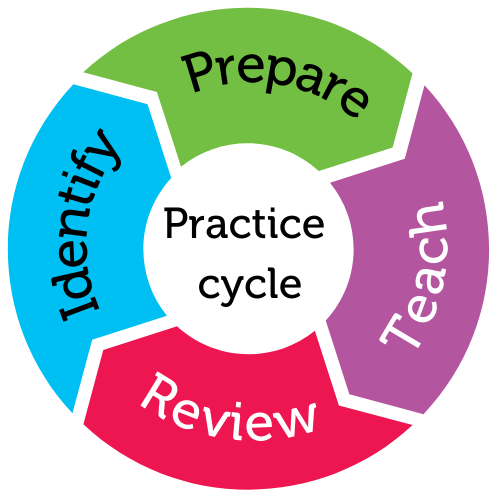
For student year
Helps students to
- Build handwriting skill
- Maintain motivation
Helps teachers to
- Support handwriting
Summary
Handwriting is a complex skill. Students need to frequently practice handwriting to become proficient. Many learning activities require handwriting skills to record information and ideas. Some students may continue to require support with their handwriting throughout their schooling.
In the first Australian educational needs analysis of students on the autism spectrum, students reported that handwriting was in the top 10 difficulties that they experienced at school. In particular,
- being neat
- being quick enough to keep up.
Supporting students to develop handwriting in the early years, including those on the autism spectrum, can be particularly challenging. These challenges can continue despite years of practice and intervention (Broun, 2009).
The Australian Curriculum requires student handwriting to be assessed up until Year 3. In this practice we provide information on how you can support students to develop their handwriting and adjustments you can make to the Australian Curriculum. This practice also includes a series of video clips featuring Helen McLennan - an occupational therapist and teacher.
Watch this video to learn more about this practice.
Duration: 02:38
Australian Professional Standards for Teachers related to this practice
1.6 - strategies to support the full participation of students with disability
2.5 - literacy and numeracy strategies
4.1 - support student participation
For further information, see Australian Professional Standards for Teachers AITSL page
Preparing to teach
Handwriting is a complex skill which requires automaticity and legibility.
- Automaticity is the ability to automatically recall how to form a letter when handwriting . This can impact the speed and length of a student’s writing as they may take longer remembering how to start writing a particular letter.
- Legibility is the ability to write letters that have consistent sizing and spacing, and to understand what has been written.
Handwriting challenges
In this video Helen talks about some of the handwriting challenges.
Duration: 01:35
In this video Helen talks about automaticity and legibility and what this means.
Duration: 02:22
Building Blocks of Handwriting
There are many skills which contribute to handwriting including fine-motor skills, visual-motor perception and motivation. Helen McLennan explains the impact of these building blocks when handwriting.
Increase your understanding of the building blocks required for handwriting.
Duration: 01:36
In this video Helen discusses why we need to address handwriting.
Duration: 03:39
The importance of practice
Despite the impact of these building blocks on handwriting, research recommends focusing on direct handwriting instruction and practice rather than underlying skills such as general fine motor activities. Technology can support handwriting skills but it should not completely replace physical handwriting practice.
This video explains more, and offers two strategies for handwriting.
Duration 06:26
In the classroom
Supporting handwriting
Helen McLennan suggests several strategies for how to address your student’s handwriting needs.
- Use an individualised approach to understand where the difficulty lies in the students’ automaticity and legibility.
- Use technology such as iPad apps as an adjustment as well as a way to teach correct letter formation.
- Involve the student and parents/carers in their handwriting by asking what they have tried before.
- When the lesson outcomes require content (such as persuasive writing), allow your students to use technology for expression. When the lesson outcomes are more flexible (such as a fun writing task or free-write), use physical handwriting so that you can home in on how the student is progressing.
In this video, Helen talks about the connection between handwriting and literacy.
Duration: 01:42
Reflection questions:
- What opportunities do you provide your students to practice handwriting ?
- What actions do you take to better support your students during handwriting tasks? Who could you seek advice and assistance from?
- How can you identify your next steps?
Success stories
In this short video - Helen shares a success story.
Duration: 02:49
Practice toolkit
Practice implementation planner template
We know it's not always easy to keep track of what's working and what isn't. So, we've created this template for you to record and reflect on what you're doing to create more inclusive classrooms. The implementation planner contains:
- guidance around goal setting
- a reflection section (what worked, didn’t work, what to change, and next steps)
- prompting questions.
Implementation planner with examples
Set your professional learning goal for:
Supporting handwriting
Benefits of goal setting
Setting, working towards, and reflecting on goals helps you grow professionally and improve your practice. You can access AITSL learning resources for teachers to learn more about:How to set goals
The Australian Institute for Teaching and School Leadership recommends using the SMART matrix to frame your goal setting.SMART goals refers to goals that are:
- Specific
- Measurable
- Achievable
- Relevant
- Time-phased
Resources
Supporting handwriting - Practice Brief
Further reading
Handwriting and the Australian Curriculum.
The National Literacy Learning Progression for handwriting and keyboarding specifies:
Not all students will use handwriting to create texts; some will express themselves using augmentative and alternative communication strategies. This may include digital technologies, braille, real objects, photographs and pictographs.
To view the Australian Curriculum handwriting standards, visit the National Literacy Learning Progressions site
Related Practices

Use technology to support written expression
TEACHING PRACTICE
For student years
Helps students to
- express ideas
- develop written expression
This practice is from the core research project
Learning Cycle

Set your practice implementation goal
Evidence
This practice was developed as part of the Overcoming written difficulties project. More information about the evidence informing this practice is available on the project page.
